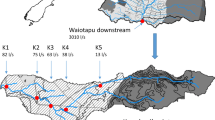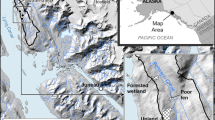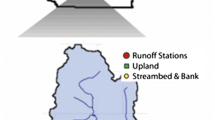Abstract
Phosphorus is considered the primary limiting nutrient in the freshwater aquatic ecosystems; thus, excessive concentrations of phosphorus (P) in streams and lakes can lead to eutrophication. Understanding the transport of P from minimally impacted watersheds provides a benchmark for quantifying human enhancement of P loss from the landscape. To better understand storm event transport of P from small watersheds of northern New England, we examined hourly variations in P in its multiple forms during three rain events at Livermore Cove Brook, New Hampshire, USA. The three storm events had different hydrological characteristics that resulted in different maximum total P concentrations. Streamwater P levels rose quickly at the onset of each event, remained high for a few hours during peak flow, and subsided as flow decreased. Dissolved organic P was the dominant species of P in the streamwater during baseflow and event flow. For each event, P concentrations were higher on the rising limbs of the hydrograph, resulting in clockwise hysteresis of the concentration-discharge relationships. Different behavior of the more inorganic, soluble reactive P hysteresis curve suggests a different source than the other P species. Both particulate and dissolved organic P were highest an hour before peak discharge and storm event water, suggesting quick mobilization of sources proximal to the stream. Soluble reactive P peaked an hour after discharge and storm event water, suggesting slower mobilization or more distal sources. Overall, these results show that storms create episodic peak concentrations of P that constitute a substantial flux of P to downstream lakes and wetlands. Consequently, efforts to manage P in New England lakes likely require greater attention to P transport during episodic storm events and their contribution to annual P loading.







Similar content being viewed by others
References
Ahl, T. (1988). Background yield of phosphorus from drainage area and atmosphere: An empirical approach. Hydrobiologia, 170, 35–44.
APHA. (1998). Standard methods for examination of water & wastewater. Amer Public Health Assn.
Bailey AS, Hornbeck JW, Campbell JL, Eagar C. 2003. Hydrometeorological database for Hubbard Brook Experimental Forest: 1955-2000. Gen. Tech. Rep. NE-305. Newtown Square, PA: US Department of Agriculture, Forest Service, Northeastern Research Station. 36 p., 305.
Bowes, M. J., House, W. A., Hodgkinson, R. A., & Leach, D. V. (2005). Phosphorus–discharge hysteresis during storm events along a river catchment: The River Swale, UK. Water Research, 39, 751–762.
Brown, V. A., McDonnell, J. J., Burns, D. A., & Kendall, C. (1999). The role of event water, a rapid shallow flow component, and catchment size in summer stormflow. Journal of Hydrology, 217, 171–190.
Caraco, N. F., Cole, J. J., & Likens, G. E. (1992). New and recycled primary production in an oligotrophic lake: Insights for summer phosphorus dynamics. Limnology and Oceanography, 37, 590–602.
Clark, G. M., Mueller, D. K., & Mast, M. A. (2000). Nutrient concentrations and yields in undeveloped stream basins of the United States. JAWRA Journal of the American Water Resources Association, 36, 849–860.
Correll, D. L. (1998). The role of phosphorus in the eutrophication of receiving waters: A review. Journal of Environmental Quality, 27, 261–266.
Dodds, W. K., Jones, J. R., & Welch, E. B. (1998). Suggested classification of stream trophic state: Distributions of temperate stream types by chlorophyll, total nitrogen, and phosphorus. Water Research, 32, 1455–1462.
Dupas, R., Gascuel-Odoux, C., Gilliet, N., Grimaldi, C., & Gruau, G. (2015). Distinct export dynamics for dissolved and particulate phosphorus reveal independent transport mechanisms in an arable headwater catchment. Hydrological Processes, 29, 3162–3178.
Foster, D. R., Donahue, B., Kittredge, D., Motzkin, G., Hall, B., Turner, B., Chilton, E. S. (2008). New England’s forest landscape: Ecological legacies and conservation patterns shaped by agrarian history. Agrarian Landscapes in Transition: Comparisons of Long-Term Ecological and Cultural Change, 344.
Gentry, L. E., David, M. B., Royer, T. V., Mitchell, C. A., & Starks, K. M. (2007). Phosphorus transport pathways to streams in tile-drained agricultural watersheds. Journal of Environmental Quality, 36, 408–415.
Green, M. B., Laursen, B. K., Campbell, J. L., McGuire, K. J., & Kelsey, E. P. (2015). Stable water isotopes suggest sub-canopy water recycling in a northern forested catchment. Hydrological Processes, 29, 5193–5202.
Haygarth, P. M., & Jarvis, S. C. (1999). Transfer of phosphorus from agricultural soil. In Advances in agronomy, vol. 66 (pp. 195–249). Academic Press.
Haygarth PM, Heathwaite AL, Jarvis SC, Harrod TR. 1999. Hydrological factors for phosphorus transfer from agricultural soils. In Advances in agronomy, Sparks DL (ed.).Academic Press; 153–178.
Hobbie, J. E., & Likens, G. E. (1973). Output of phosphorus, dissolved organic carbon, and fine particulate carbon from Hubbard Brook watersheds. Limnology and Oceanography, 18, 734–742.
Holko, L., Kostka, Z., & Šanda, M. (2011). Assessment of frequency and areal extent of overland flow generation in a forested mountain catchment. Soil and Water Research, 6(1), 43–53.
Holman, I. P., Whelan, M. J., Howden, N. J., Bellamy, P. H., Willby, N. J., Rivas-Casado, M., & McConvey, P. (2008). Phosphorus in groundwater—An overlooked contributor to eutrophication? Hydrological Processes: An International Journal, 22(26), 5121–5127.
Hooper, R. P., & Shoemaker, C. A. (1986). A comparison of chemical and isotopic hydrograph separation. Water Resources Research, 22, 1444–1454.
House, W. A., & Warwick, M. S. (1998). Hysteresis of the solute concentration/discharge relationship in rivers during storms. Water Research, 32, 2279–2290.
Janke, B. D., Finlay, J. C., Hobbie, S. E., Baker, L. A., Sterner, R. W., Nidzgorski, D., & Wilson, B. N. (2014) Contrasting influences of stormflow and baseflow pathways on nitrogen and phosphorus export from an urban watershed. Biogeochemistry, 121(1), 209–228.
Jeppesen, E., Kronvang, B., Meerhoff, M., Søndergaard, M., Hansen, K. M., Andersen, H. E., Lauridsen, T. L., Liboriussen, L., Beklioglu, M., Özen, A., & Olesen, J. E. (2009). Climate change effects on runoff phosphorus loading and lake ecological state and potential adaptations. Journal of Environmental Quality, 38, 1930–1941.
Lannergård, E. E., Ledesma, J. L., Fölster, J., & Futter, M. N. (2019). An evaluation of high frequency turbidity as a proxy for riverine total phosphorus concentrations. Science of the Total Environment, 651, 103–113.
Lloyd, C. E. M., Freer, J. E., Johnes, P. J., & Collins, A. L. (2016). Using hysteresis analysis of high-resolution water quality monitoring data, including uncertainty, to infer controls on nutrient and sediment transfer in catchments. Science of the Total Environment, 543(Part A), 388–404.
Lowrance, R., Altier, L. S., Newbold, J. D., Schnabel, R. R., Groffman, P. M., Denver, J. M., Correll, D. L., Gilliam, J. W., & Robinson, J. L. (1997). Water quality functions of riparian forest buffers in Chesapeake Bay watersheds. Environmental Management, 21, 687–712.
Mattsson, T., Finér, L., Kortelainen, P., & Sallantaus, T. (2003). Brook water quality and background leaching from unmanaged forested catchments in Finland. Water, Air, and Soil Pollution, 147(1–4), 275–298.
McDiffett, W. F., Beidler, A. W., Dominick, T. F., & McCrea, K. D. (1989). Nutrient concentration-stream discharge relationships during storm events in a first-order stream. Hydrobiologia, 179, 97–102.
McDowell, R., Sharpley, A., & Folmar, G. (2001). Phosphorus export from an agricultural watershed. Journal of Environment Quality, 30, 1587.
Mellander, P.-E., Jordan, P., Shore, M., Melland, A. R., & Shortle, G. (2015). Flow paths and phosphorus transfer pathways in two agricultural streams with contrasting flow controls. Hydrological Processes, 29, 3504–3518.
Menzel, D. W., & Corwin, N. (1965). The measurement of total phosphorus in seawater based on the liberation of organically bound fractions by persulfate oxidation1. Limnology and Oceanography, 10, 280–282.
Meyer, J. L., & Likens, G. E. (1979). Transport and transformation of phosphorus in a forest stream ecosystem. Ecology, 60, 1255–1269.
Moore, R. B., Johnston, C. M., Robinson, K. W., & Deacon, J. R. (2004). Estimation of total nitrogen and phosphorus in New England streams using spatially referenced regression models (No. 2004-5012). US Department of the Interior, US Geological Survey.
Pinder, G. F., & Jones, J. F. (1969). Determination of the ground-water component of peak discharge from the chemistry of total runoff. Water Resources Research, 5, 438–445.
Quinton, J. N., Govers, G., Van Oost, K., & Bardgett, R. D. (2010). The impact of agricultural soil erosion on biogeochemical cycling. Nature Geoscience, 3, 311–314.
Rodríguez-Blanco, M. L., Taboada-Castro, M. M., Taboada-Castro, M. T., & Oropeza-Mota, J. L. (2009). Nutrient dynamics during storm events in an agroforestry catchment. Communications in Soil Science and Plant Analysis, 40, 889–900.
Rodríguez-Blanco, M. L., Taboada-Castro, M. M., & Taboada-Castro, M. T. (2013). Phosphorus transport into a stream draining from a mixed land use catchment in Galicia (NW Spain): Significance of runoff events. Journal of Hydrology, 481, 12–21.
Sharpley, A. N. (1985). Depth of surface soil-runoff interaction as affected by rainfall, soil slope, and management 1. Soil Science Society of America Journal, 49(4), 1010–1015.
Sharpley, A. N., & Syers, J. K. (1979). Phosphorus inputs into a stream draining an agricultural watershed. Water, Air, and Soil Pollution, 11(4), 417–428.
Sharpley, A. N., Weld, J. L., Beegle, D. B., Kleinman, P. J. A., Gburek, W. J., Moore, P. A., & Mullins, G. (2003). Development of phosphorus indices for nutrient management planning strategies in the United States. Journal of Soil and Water Conservation, 58, 137–152.
Sklash, M. G., & Farvolden, R. N. (1979). The role of groundwater in storm runoff. Journal of Hydrology, 43, 45–65.
Sklash, M. G., Farvolden, R. N., & Fritz, P. (1976). A conceptual model of watershed response to rainfall, developed through the use of oxygen-18 as a natural tracer. Canadian Journal of Earth Sciences, 13, 271–283.
Squam Lakes Association. (2002). Report on the tributary monitoring program 1999–2000. New Hampshire: Squam Lake.
Wang, J., & Pant, H. K. (2010). Phosphorus sorption characteristics of the Bronx River bed sediments. Chemical Speciation & Bioavailability, 22, 171–181.
Williams, M. R., King, K. W., Ford, W., Buda, A. R., & Kennedy, C. D. (2016) Effect of tillage on macropore flow and phosphorus transport to tile drains. Water Resources Research, 52(4), 2868–2882.
Acknowledgments
We thank Todd Dickinson for the help in collecting water samples and lab analysis. Thanks to Jeff Schloss for measuring discharge in the Livermore Cove Brook. We also thank an anonymous reviewer who helped improve an earlier version of this manuscript.
Author information
Authors and Affiliations
Corresponding author
Additional information
Publisher’s Note
Springer Nature remains neutral with regard to jurisdictional claims in published maps and institutional affiliations.
Rights and permissions
About this article
Cite this article
Shrestha, A., Green, M.B., Boyer, J.N. et al. Effects of Storm Events on Phosphorus Concentrations in a Forested New England Stream. Water Air Soil Pollut 231, 376 (2020). https://doi.org/10.1007/s11270-020-04738-0
Received:
Accepted:
Published:
DOI: https://doi.org/10.1007/s11270-020-04738-0




